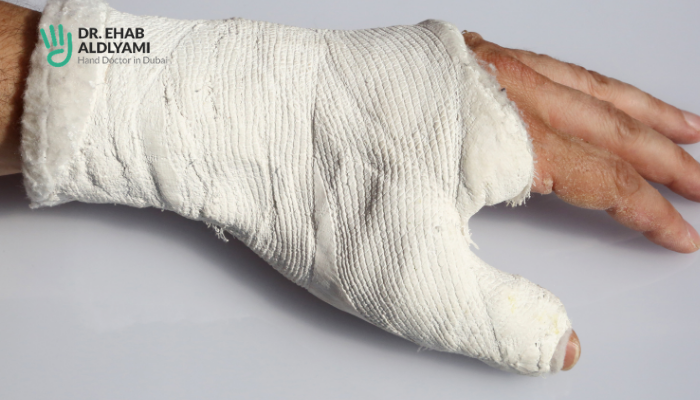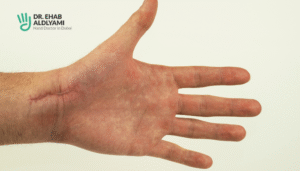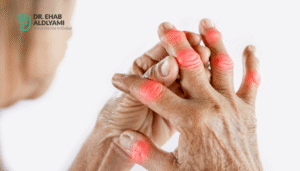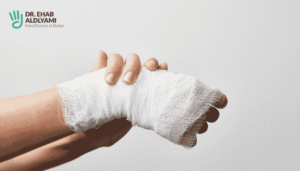Broken Hand – Diagnosis & Treatment

The bones of the hand provide structural support, facilitating the movement of muscles that control the wrist and fingers. If one of these hand bones becomes fractured, it can impair hand, wrist, and finger function, limiting their mobility and usability. It can result in pain, swelling, bruising, and difficulty in movement.
Broken hand treatment depends on the severity and location of the fracture. They may include immobilisation with a splint or cast, pain management, physical therapy, and, in some cases, surgery to realign the bones. Seeking prompt medical attention is crucial for proper diagnosis and treatment to ensure optimal healing and restoration of hand function.
Types of Fractures
Some may believe that a fracture and a break are distinct, but they are synonymous. Fractures can manifest in various forms, such as:
- Stable fracture: Bone pieces remain aligned
- Unstable fracture: Bone fragments have shifted
- Comminuted fracture: Bone shatters into multiple pieces
- Open (compound) fracture: Bone fragment penetrates the skin, increasing infection risk
Signs and Symptoms
Indications of a broken hand may encompass:
- Pain and rigidity
- Challenges in hand, wrist, and/or finger mobility
- Deformities like a bent finger (though less common)
Working with a fractured hand
Working with a fractured hand can be challenging, but it’s possible with some adjustments and precautions to ensure proper healing and avoid further injury.
Here are some tips for working with a fractured hand:
- Follow your doctor’s recommendations: It’s crucial to follow your doctor’s advice regarding activity limitations, immobilisation, and rehabilitation exercises.
- Use protective gear: Depending on your job duties, consider using protective gear such as a splint, brace, or glove to support and protect your fractured hand while working.
- Take frequent breaks: Take regular breaks to rest your hand and prevent overexertion. Avoid repetitive motions or activities that exacerbate pain or discomfort.
- Practice good ergonomics: Maintain proper posture and workstation ergonomics to reduce strain on your hands and wrists. Use ergonomic tools and equipment designed to minimise stress on the hands.
- Seek assistance when needed: Don’t hesitate to ask for help with tasks that are difficult or painful to perform with a fractured hand. Collaborate with coworkers or supervisors to ensure tasks are completed safely.
Diagnosis
The process of diagnosing a broken hand typically involves a comprehensive physical examination of the affected hand, wrist, and fingers, coupled with the utilisation of X-ray imaging technology.
Treatment for Broken Hand
If the fractured bone ends are not properly aligned, gaps may form between the bone pieces or fragments may overlap. Your physician will need to manipulate the fragments back into their correct position through a procedure called reduction. Depending on the level of pain and swelling, you may require either a local or general anaesthetic before this procedure.
Immobilisation
Immobilisation is crucial for promoting proper healing of a broken hand bone. Typically, this involves the use of a splint or cast. Elevating your hand above heart level whenever possible can help reduce swelling and alleviate pain.
Medication
To manage pain, your doctor may suggest over-the-counter pain relievers. In cases of severe pain, opioid medications like codeine may be prescribed. While NSAIDs can alleviate pain, long-term use may hinder bone healing, so it’s important to consult with your doctor before using them.
Physiotherapy
Following the removal of your broken hand cast or splint, rehabilitation exercises or physical therapy may be necessary to reduce stiffness and restore movement in your hand. Although rehabilitation can be beneficial, complete healing may take several months or even longer.
Surgical Intervention
In some cases, surgical intervention may be required to ensure proper healing. This may involve implanting pins, plates, rods, or screws to stabilise the bones during the healing process. Additionally, a bone graft may be necessary to facilitate healing. Surgery may be recommended if you have an open fracture, significant bone displacement, loose bone fragments, or damage to surrounding ligaments, nerves, or blood vessels.
Regular X-rays may be conducted to monitor your progress, and if any bone movement is detected, further surgical intervention may be necessary.
Broken hand recovery time
The recovery time for a broken hand varies depending on factors such as the severity of the fracture, the treatment received, and individual healing rates. In general, mild fractures may heal within 4 to 6 weeks with proper immobilisation and rehabilitation. However, more severe fractures or those requiring surgical intervention may take longer, ranging from several weeks to several months.
Following the initial healing period, rehabilitation exercises or physical therapy may be necessary to restore strength, flexibility, and function to the hand. It’s essential to follow your doctor’s recommendations and attend all scheduled follow-up appointments to monitor healing progress and ensure optimal recovery.
Suspecting a broken or fractured hand? Consult our hand expert Dr. Ehab Bassim Aldlyami
If you suspect a broken or fractured hand, seeking prompt medical attention is crucial for proper diagnosis and treatment. Our hand expert, Dr. Ehab Bassim Aldlyami Orthopedic Hand Surgeon in Dubai, specialises in diagnosing and treating hand injuries in Dubai, including fractures and breaks. With his expertise and experience, Dr. Ehab provides comprehensive care to address your specific needs and facilitate optimal broken hand treatment.
Consult Dr. Ehab today to receive personalised treatment and support on your journey to recovery.
What is the best treatment for a broken hand?
The best treatment for a broken hand depends on the severity and location of the fracture. In most cases, the treatment involves immobilization with a splint or cast to allow the bones to heal properly. Pain management, physical therapy, and, in some cases, surgery may also be recommended based on the specific circumstances of the injury.
How long does a broken hand take to heal?
The healing time for a broken hand varies depending on factors such as the severity of the fracture, the individual’s overall health, and the effectiveness of treatment. Generally, it takes about 6 to 8 weeks for a broken hand to heal. However, some fractures may take longer to heal completely, and rehabilitation may be needed to regain the full function of the hand.
Can a broken hand heal without surgery?
Yes, many broken hands can heal without surgery, especially if the fracture is not displaced or severely unstable. Non-surgical treatment options such as immobilisation with a splint or cast, pain management, and physical therapy are often effective in promoting healing and restoring function. However, in some cases, surgery may be necessary to realign the bones or stabilise the fracture if conservative measures are not sufficient.
What are the 5 stages of fracture healing?
The five stages of fracture healing are:
- Hematoma formation: Blood vessels around the fracture site rupture, leading to the formation of a blood clot (hematoma).
- Inflammatory phase: The body’s immune response triggers inflammation, leading to the removal of dead tissue and debris from the fracture site.
- Soft callus formation: New blood vessels and cartilage form around the fracture, creating a soft callus that stabilises the bone.
- Hard callus formation: Osteoblasts produce new bone tissue, forming a hard callus that bridges the fracture gap.
- Remodeling: Over time, the hard callus is reshaped and remodelled into mature bone tissue to restore the bone’s original strength and structure.
How do you heal a broken hand quickly?
To heal a broken hand quickly, follow your doctor’s treatment plan diligently, including immobilisation, pain management, and physical therapy.
Rest and protect the hand, elevate it above heart level to reduce swelling, and apply ice packs for short periods several times a day.
Maintain a healthy diet, quit smoking, and stay hydrated.
Engage in gentle movement as recommended by your doctor or physical therapist, attend follow-up appointments, and avoid rushing the recovery process to ensure proper healing.










